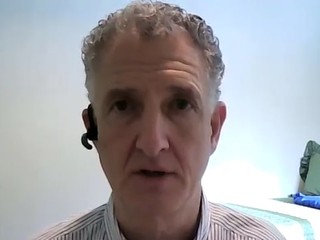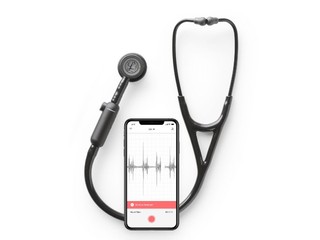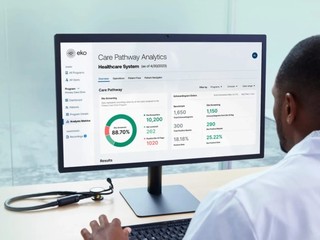The FDA outlines draft guidance on AI for medical devices
The agency also published draft guidance on the use of AI in drug development
Read more... Heart failure with reduced ejection fraction (HFrEF) happens when the heart's left ventricular ejection fraction (LVEF) is 40% or less, a sign of a weak heart pump. The problem is that this sign of heart failure has remained undetectable during a physical exam, meaning most patient don't know they have it until they have a health scare.
Heart failure with reduced ejection fraction (HFrEF) happens when the heart's left ventricular ejection fraction (LVEF) is 40% or less, a sign of a weak heart pump. The problem is that this sign of heart failure has remained undetectable during a physical exam, meaning most patient don't know they have it until they have a health scare.
"The standard of care today is that the ejection fraction is measured using an echocardiogram, which is a much more time intensive, expensive test that's usually done in a specialty setting. And even if it is done in primary care, it's usually after the suspicion of underlying disease," said Jason Bellet, co-founder of Eko, a smart stethoscope company that uses AI to help providers identify early signs of cardiovascular disease.
"The wait lists for echocardiography in the US can go from months, the cost is still incredibly high, and the patient fall through from being referred to an echocardiogram to actually showing up and getting it was also pretty significant. So, what happens is, even when patients start to exhibit some symptoms, and may be referred to a specialist, you see a pretty considerable delay and rate of drop off."
Founded in 2013, Eko has developed devices that can be used to better hear heart and lung sounds, after which its machine learning algorithms interpret that data and provide better insights. One of those algorightm includes a Low EF detection AI, which can use to detect low EF in 15 seconds during a routine physical examination.
Now that algorithm will be available to health systems and physicians nationwide as Eko's Low EF detection AI has been cleared by the FDA it was announced on Tuesday, making it the first AI to aid heart failure detection during routine check-ups.
Founded in 2013, Eko has three stethoscopes it sells to individual clinicians, hospitals, departments and health systems. Its first device is the CORE stethoscope, which amplifies sound up to 40X, and can also capture, save and share sounds and can be connected to a smart device via Bluetooth. The second is the DUO stethoscope, which can be used in the clinic or by patients at home; it's an ECG and digital stethoscope combined, and made to be handheld, easy to use, and very non-challenging so patients can use it.
It's third device is called the 3M Littmann CORE Digital Stethoscope, which combines its digital and software capabilities with the acoustic stethoscope from 3M.
All of Eko's stethoscopes pair with a mobile application, which will alert physicians, flag the heart sound with a low ejection fraction detection alert, at which point the next step in care would be to refer the patient for a diagnostic echocardiogram.
"We are really a clinical decision support tool, not a diagnostic tool. So, in that physical exam, our goal is to inform the physician that there is a high potential that this patient has heart failure. The standard of care from primary care is to then refer that patient to cardiology, just like they would normally if they were to hear a concerning murmur or see a concerning mole," Bellet explained.
"The idea really with primary care is to flag early and then get those patients referred to a specialist in the event they need to be diagnosed with a specific condition."
The algorithm was developed in conjunction with the Mayo Clinic; in fact, they were the ones who first discovered that low ejection fraction could be detected using a machine learning algorithm trained on ECGs and echocardiogram pairs.
"The Mayo Clinic was able to take the millions of ECGs that they had paired up with echocardiograms and actually deploy a data science team to train a novel machine learning algorithm to identify a characteristic within the ECG that was previously unknown to the naked eye that correlated to ejection fraction," said Bellet.
Where Eko came into the picture was to solve the challenge of how to get the algorithm to as many patients as possible. Now, using its stethoscopes, which have a built in EKG, providers will be able to screen for this previously undetectable sign of heart failure during a physical exam.
The Low EF AI will be added to Eko’s SENSORA Cardiac Early Detection Platform, combining it with Eko's other algorithms for Afib detection and structural heart murmur detection, giving physicians a comprehensive cardiac early detection tool, allowing them to potentially discover if a patient has low EF months, if not years, before they might have had a health event.
"Oftentimes, heart failure, particularly with reduced ejection fraction, isn't diagnosed until that patient shows up in the ER, or worse. And that is often because some of the symptoms can be dismissed and can be viewed as one of many things," Bellet explained.
Trained on a proprietary dataset of over 100,000 ECGs and echocardiogram pairs from unique patients Eko’s Low EF AI was clinically validated in a clinical study of 3,456 patients, achieving an area under the receiver operating characteristic (AUROC) of 0.835 for detection of left ventricular ejection fraction (LVEF) below 40%, 74.7% sensitivity, and 77.5% specificity.
In addition, Imperial College London Independent ran an independent validation of the Low EF AI, reporting an AUROC of 0.85 for detection of LVEF below 40%, 84.8% sensitivity, and 69.5% specificity when deployed on over 1,050 patients.
These results prompted the UK NHS and Imperial College London to extend Eko's deployment to over 100 clinics in London and Wales.
"The way to think about this is looking at measuring it against the standard of care today, which is really the complete inability to do this detection in a primary care setting. The idea here is, particularly for patients at risk, so those above a certain age or with other comorbidities, is to be able to deploy this as a quick, early detection tool," said Bellet.
While the FDA clearance means that the Low EF detection AI could be deployed to all of the 500,000 healthcare professionals who use currently Eko's technology at the point of care, the company plans to do a slow roll-out, initially focusing on working with a small group of health systems, doing early pilots, and commercial studies before expanding it to a larger group of customers.
The plan is to have it available to couple of thousand physicians by the end of the year.
Currently, Eko's telehealth solutions are deployed to about 100 health systems, but its AI solutions are used by under 10, as it the company is still in the earlier phases of rolling out the AI as it gets some of these more novel indications cleared. Even though it's early days, however, using the AI to not only detect heart and lung sounds, but to then make that data actionable, is Eko's vision for the future of Eko.
"We obviously have our stethoscopes which are FDA cleared and digitize the heart and lung sounds and bring this analog tool, which is the icon of medicine, into the digital age. But Eko very much at its core is an AI and software company. And so, now that we've digitized heart lung sounds, the next chapter in our journey is making that data really actionable for clinicians at the bedside," Bellet explained.
"A lot of the innovation that you'll see coming out of Eko over the next many years will be new algorithms that help healthcare professionals take that 15 seconds of heart sound data, ECG data, or lung sound data and analyze it for the presence of an underlying condition."
The agency also published draft guidance on the use of AI in drug development
Read more...The biggest focus areas for AI investing are healthcare and biotech
Read more...It will complete and submit forms, and integrate with state benefit systems
Read more...

